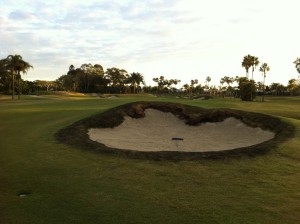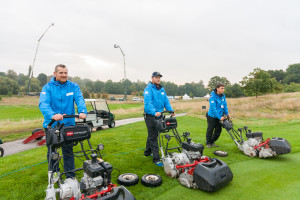
Many clubs will be well into their winter works programmes, budgets permitting. This is often associated with drainage improvements around the course or may include refurbishment, new build or extensions to bunkers, tees and greens.
Most leaves will have fallen by now, so a last big tidy up before Christmas usually sees the back of this annual task. The job of clearing up these leaves and debris will be a priority. Allowing leaves to rot on your sward will lead to turf damage. Switching, brushing, blowing or caning the greens each morning will be a priority task to remove any leaf debris and early morning dew.
As we head towards the winter months, soil and air temperatures will be dropping and early morning frosts will become a familiar sight to most groundsmen.
Key Tasks for December

Other tasks that complement this work involve the use of grooming and verticutting units to remove unwanted thatch and side shoot growth.
Mowing frequencies will vary from daily to twice weekly operations dependant on the growth of the grass and the standards set by the Course Manager. Mowing heights may vary depending on local conditions, type of course, course expectations, sward type and mower type.
The mowing heights are a guide, and will be subject to local weather conditions, but remember not to remove more than 1/3 of total grass height in each cut. The less stress that is placed on the grass at this vital time the better the results further on into the next season.
Greens. Mowing height should be maintained at around 6-8mm.
Tees. Mowing height should be maintained at around 10-15mm.
Banks. Mowing height should be maintained at 22-30mm
Fairways. Mowing height should be maintained at around 15-25mm.
Rough, semi rough grass areas. Mow and tidy up these areas. Reduce build up of clippings by cutting little and often with a rotary or flail. Mowing height will depend on type of course and the standard of play required. Height of cut during the winter between 50-100mm.
As we progress through the month, air temperatures are likely to lower, with many courses experiencing morning frosts. It is important to prevent people from walking over the grass surfaces (preventing surface damage to the sward) during frosty conditions. Courses should be kept closed if possible during heavy frosts. The decision to close the course, or parts of the course, should be down to the Course Manager/Head Greenkeeper. Effective communication is essential to inform all parties of the decision. This is usually in the form of signage and messages to confirm the reason and the expected time the course, or parts of the course, will be closed.
This may also involve the restriction on using buggies and, in some instances, trolleys on the course. Winter tee mats and temporary greens may also come into play, with many golf courses resting their competition tees and greens.
Changing of holes should be carried out regularly, however frequency will be dependant on a number of factors, green size, green construction, tournaments, amount of play and condition of the green.

Fertiliser programmes are not generally carried out after November due to the change in air and soil temperatures as most turf grasses usually start to become dormant, slower growing. However, some greenkeepers may apply some liquid iron to keep the turf healthy and strong. USGA greens often do require some top-up feeding during the winter to maintain the nutrient status of the green.
Inspect, weed and rake bunkers. Repair any damage from rabbits or other animals, maintain sand up the face of the bunkers to prevent erosion and sand loss.
Some golf courses experience flash floods during heavy rain fall, leaving many bunkers in a poor state (washing out sand from bunker faces). Repair works may be necessary.
Bunker construction work may be ongoing in December, subject to ground conditions allowing for transport of materials around.
Aeration of tees will continue throughout the winter when weather conditions allow. A wide range of solid or slit aerators are put to use on the greens. It is essential to keep the greens aerated to maintain air and gas exchange in the soil profile, thus improving the drainage capabilities of the greens.
Aeration of tees will continue throughout the winter when weather conditions allow.
When the ground conditions are favourable, aerate fairways with solid tines to increase air and gas exchanges in soil profile. Encouraging deeper rooting of fairway grasses is important. Deeper rooted grasses are more likely to overcome stresses during the following year.




Hardening off the plant with applications of iron ahead of any forecasted cold nights and biting winds will serve to thicken the plants cell walls and make it more resilient. Equally, should soil temperatures remain above 8°C the plant will be requiring some nutrition, with low nitrogen options remaining relevant.The delicate balance will be to avoid turf stress where autumn feeds may be running low but without stimulating soft susceptible growth from any applications of nitrogen.
If milder weather is forecast, repairing worn areas and severe divots with a low temperature germinating Perennial rye-grass mixture will give it every opportunity to germinate and begin establishment.
Applications of Carbendazim will continue to be required to areas which are subject to high levels of worm activity. Controlling the casting will also make a significant contribution to reducing greasy and smearing surfaces which helps to prevent turf wear.
As long as ground conditions are suitable aeration in any form is key to maintaining surface drainage and soil respiration.
As temperatures reduce and moisture is present on the leaf for longer, Microdochium patch is still likely to be virulent; the window for systemic fungicides has likely passed, with products containing a contact mode of action proving to be the most suitable method of control. Users should be aware that correct and high quality application is vital for the success of any spray operation. This is especially so with a contact fungicide where the idea is to effectively coat the leaf in a protective ‘jacket’ of the substance which will ward of disease attack. Ensuring sprayers are well calibrated, label recommendations are adhered to, nozzles are appropriate and in good condition are all factors crucial to success as 10-20% of spraying efficacy is down to spray quality. Nozzles should be replaced annually and when the cost of a set of nozzles is set against the cost of a fungicide, the final 10-20% of efficacy more than pays for them.
Turf managers should maintain good cultural methods of control for disease with timely removal of morning dews – to reduce periods of leaf blade wetness – and the considered use of liquid irons, phosphite and calcium – routinely applied to provide the plant with its own defences – all forming the backbone of an holistic approach to responsible Integrated Turf Management (ITM) .
Finally, maintaining oneself and team is equally important throughout periods of inclement weather, and investment in good clothing helps to maintain comfort, morale and productivity.

Earthworms may be a problem, so regular dragbrushing will be necessary. Brushing can be daily when conditions are right. Regular aeration to keep the surface open will aid drying. A drier surface may help towards reducing the effects of the earthworm activity near the surface. Diseases have been widely reported, particularly Fusarium. These outbreaks have been mainly due to the heavy dews and changing climatic air temperatures we have recently experienced.
The three disease factors: susceptible grass/host, pathogen, and environment, provide the evidence for disease diagnosis. Symptoms are the expression of the susceptible grass to the disease and can take on a variety of forms.
Symptoms may appear on the leaves as small, circular, tan-coloured lesions surrounded by brown or purple borders (leaf spotting); as yellow, red, or tan blotches over most or all of the leaf blade (blighting); stunting; wilting; or as a brown or black rot on the crowns and roots. The appearance of these symptoms will also vary depending on the type of disease, the severity of the attack and the developing stage of the disease.
The typical types of diseases you may come across are:
- Fusarium
- Red Thread
- Dollar Spot
Please note: More information on these and many others can be found here: https://www.pitchcare.com/useful/diseases.php

So, it is important we look after and maintain these valuable machines, carrying out regular servicing and repairs.
It is also important to get your staff trained to use specific machinery/equipment.
Most clubs do have wash down facilities; it is important to inspect and clean machinery after use.
Maintain a stock of consumables for your machinery, replace worn and damaaged parts when necessary.
Provide adequate storage space for machinery, secure machinery with good locks, and record make and models or, better still, take pictures of your equipment.

Some of the courses available are:
Chainsaws - CS30 and CS31
H&S Refresher Training on Combined Turf Care Equipment; Tractors and Trailers; All Mowers (Ride-on and Pedestrian)
Machinery Courses on ATVs; Tractors: Brushcutters/Strimmers; Mowers (ride-on and Pedestrian)
Pesticide Application (PA courses)
Stem Injection of Invasive Species (Japanese Knotweed etc.)
Basic Trees Survey and Inspection
More details about all the courses can be found here, or you can email Chris Johnson for information.
Inspect drainage outfalls, channels and ditches. Ensure that they are working. It is during the winter months that most golf course managers/greenkeepers can evaluate the condition and performance of their drainage systems.
Inspect, check and empty all litter bins
Time to organise winter servicing of machinery
Keep stock of all materials
Tidy mess rooms and sheds


